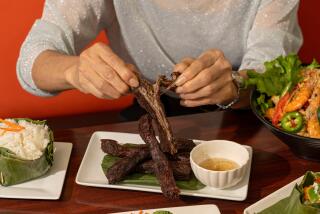Exotic if Unsafe Journey
- Share via
ON THE TONLE SAP, Cambodia — The boat breaks just about every safety regulation, and the dining service comes out of a red plastic bucket. It even sometimes draws gunfire from “bad elements” along the way.
But the water route to the magnificent temples of Angkor is an exotic journey through the heart of Cambodia.
It is a trip nearly all foreigners miss. Most take the half-hour, $55 plane ride from the capital, Phnom Penh, to Siem Reap, the town around which the ancient temples are arrayed.
Only the adventurous or budget-minded take the river journey. For $25 each way, they get stuffed into a long, narrow boat with throngs of Cambodians and their crates, caged animals and other baggage.
In the Asian tradition of “pack them in for maximum profit, never mind a possible catastrophe,” the Golden Sea 5’s “Capacity 62” sign is crossed out to read 76. The actual number on my trip pushes 100. Only a single life jacket can be seen, haphazardly slung near the front of the cabin.
To escape the crowding and the boat’s offerings of videotaped Chinese gangster movies, some passengers climb up on the cabin roof. Once on deck, discomfort gives way to a parade of bucolic scenes.
As the Golden Sea 5 scoots up the Tonle Sap from Phnom Penh, the graceful roofs of houses on stilts and Buddhist temples peep above the palm groves. Lithe old men row by with single oars, standing up in their frail canoes. Youngsters fish and romp along the riverbanks.
A feeding frenzy erupts during a brief stop at Kompong Chhnang as vendors force their way into the boat hawking greasy chicken and grabbing bunches of bank notes from passengers. Otherwise it’s warm Coke and candy sold on board by a young boy.
The boat veers to the northwest, through mangroves alive with herons and scudding fish, and into the Great Lake, Southeast Asia’s largest body of freshwater and one of the world’s richest fishing grounds. It is Cambodia’s leading source of protein.
At the lake’s northwestern corner, near Angkor, we pass through a vast floating village: houses, shops, classrooms, even pigpens bob on rafts. The families rely almost solely on the lake’s bounty.
Our secondhand, Malaysian-made boat makes the 150-mile trip in six hours. A few days later, a sister boat sprang a leak and passengers had to ride to Phnom Penh in trucks. Another boat recently ran out of fuel in the middle of the lake.
There are occasional shootings, whether by Khmer Rouge guerrillas, renegade government soldiers or angry fishermen is hard to say. Cambodia’s countryside is pretty lawless.
On my trip, a government soldier briefly pursued us in a small motorboat and fired a single shot from his machine gun in our direction. Some passengers speculated that he was after a bribe. Others thought he was joking.
More to Read
Sign up for The Wild
We’ll help you find the best places to hike, bike and run, as well as the perfect silent spots for meditation and yoga.
You may occasionally receive promotional content from the Los Angeles Times.






